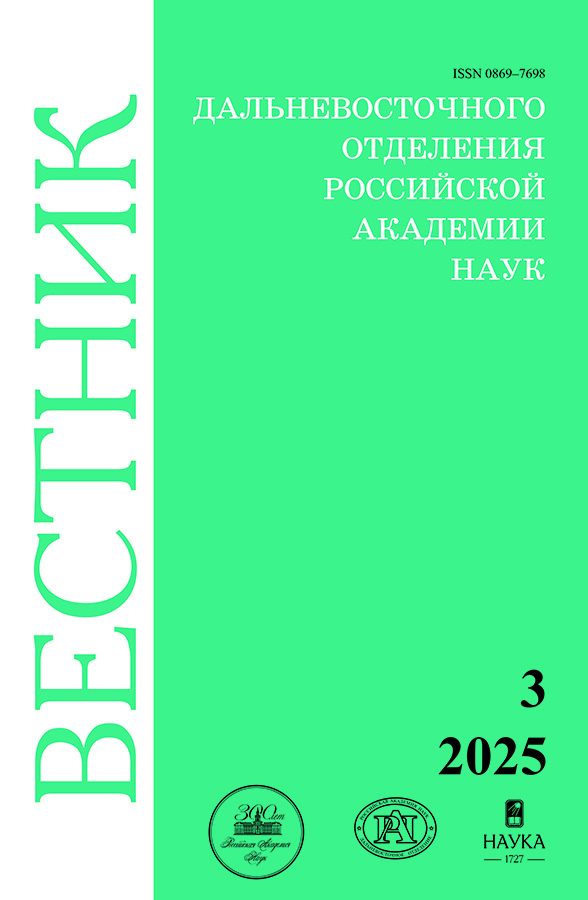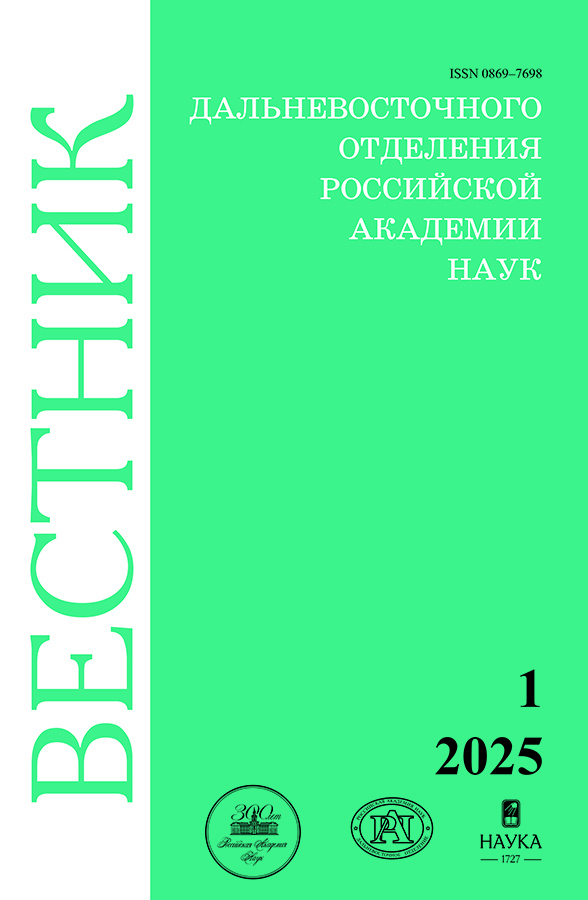№ 1 (2025)
Биотехнология
Влияние почвенного состава на рост и развитие растений базилика
Аннотация
В работе исследуется развитие растений базилика Ocimum basilicum L. в зависимости от состава почвенной смеси при выращивании с помощью светодиодного излучения в закрытых условиях. Изучалось влияние на растения комбинаций удобрений Кристалон и Цион с песком. Показано, что использование комплексного удобрения Кристалон приводит к наибольшим значениям морфометрических параметров растений базилика. Выращенные с его помощью растения имели значения массы надземной части растений в 45 раз большие, чем контрольные. Применение удобрения Цион привело к увеличению этого параметра относительно контроля в 11 раз. Добавление в смеси песка способствовало снижению массы надземной части растений базилика, выращенных в почвенной смеси с Кристалоном, на 15%, Ционом – на 37%, а в почвенной смеси без добавок – на 7%. Использование удобрения Кристалон позволило вырастить растения базилика, имеющие на 35-й день массу надземной части, равную 14 г, что сравнимо с результатами, получаемыми при помощи беспочвенных методов. Данный результат показывает перспективность использования удобрения Кристалон для выращивания данной культуры в короткие сроки в почве, сохраняя все преимущества данного метода.
 5-18
5-18


Влияние спектрального состава и интенсивности света на развитие микрорастений Solanum tuberosum L.
Аннотация
В работе исследуется влияние на развитие микрорастений картофеля (Solanum tuberosum L.) сорта Рэд Скарлетт монохроматического света красного, зеленого и синего диапазонов спектра с различным уровнем интенсивности облучения (30–1400 мкмоль/с · м2). Наибольшие значения параметров высоты и массы растений наблюдались у образцов, культивированных при красном свете, а наименьшие – в группах с освещением синим светом. Синий свет ограничивал рост стебля и больше способствовал образованию крупных листьев. Морфометрические показатели растений, выращенных при зеленом свете, были выше, чем культивированных при синем, однако меньше значений образцов из секций с красным светом. Оптимальными для развития микрорастений картофеля были интенсивности освещения: при СС и ЗС – 500–600 мкмоль/с · м2, при КС – 800–1000 мкмоль/с · м2.
 19-30
19-30


О возможности управления динамикой развития хлореллы (Chlorella vulgaris) в пресноводных акваториях под воздействием инфракрасных лазеров
Аннотация
Интенсивная сельскохозяйственная деятельность ведет к загрязнению и цианобактериальному цветению пресноводных акваторий, что угрожает не только здоровью людей, но и флоре и фауне водной среды. В работе рассмотрены результаты исследований воздействия на развитие Chlorella vulgaris электромагнитных излучений различных длин волн. С этой целью было проведено облучение выращенной суспензии Chlorella vulgaris в питательном растворе с помощью ЭМИ различных диапазонов длин волн: в ультрафиолетовом (UV) с длиной волны 220 и 253 нм, в зеленом (Gr) с длиной воны 520 нм, в красном (R) с диапазоном излучения 625 нм и в инфракрасном (IR) в диапазоне 1200–1400 нм. В результате проведенных экспериментов было установлено, что воздействие UV излучения в обоих диапазонах длин волн 220 и 253 нм, а также действие Gr при длине волны 520 нм не привело к изменению показателя концентрации клеток хлореллы в тестируемых образцах по сравнению с контрольными образцами в течение 6 сут измерений после облучения. В то же время в образцах, облученных R и IR соответственно при длинах волн 625 и 1200–1400 нм, наблюдался рост концентрации клеток хлореллы в суспензии примерно вдвое по сравнению с контрольным образцом. Авторы считают наиболее перспективным применение именно инфракрасного диапазона электромагнитного спектра при воздействии на хлореллу с целью активизации ее роста. Между тем при подборе длины волны в ИК диапазоне рекомендуется учитывать оптические окна прозрачности атмосферы над водоемами.
 31-39
31-39


Химические науки
Исследования низкомолекулярных метаболитов морских звезд: структуры, биологические активности и биосинтез
Аннотация
Исследованы полярные стероидные соединения, сфинголипиды и тритерпеновые гликозиды некоторых видов тропических и дальневосточных морских звезд. Установлены их химические структуры, изучена биологическая активность, а также предположены пути биосинтеза. Многие из выделенных соединений имеют уникальное химическое строение и содержат необычные структурные фрагменты.
 40-53
40-53


Применение метаболомных подходов для анализа вторичных метаболитов морских звезд и голотурий в Тихоокеанском институте биоорганической химии им. Г.Б. Елякова ДВО РАН
Аннотация
Полярные стероидные соединения морских звезд и тритерпеновые гликозиды голотурий являются уникальными биологически активными вторичными метаболитами, имеющими необычные химические структуры и разнообразные биологические эффекты. Применение метаболомных подходов с использованием масс-спектрометрических методов для изучения экстрактов морских беспозвоночных позволяет обнаружить большое число ранее не изученных, в том числе минорных, соединений, быстро охарактеризовать полный набор метаболитов, идентифицировать известные соединения и предположить структуры или получить структурную информацию о строении отдельных частей молекул для новых соединений. В статье кратко обсуждаются основные достижения в исследовании вторичных метаболитов морских звезд и голотурий с применением метаболомных подходов в Тихоокеанском институте биоорганической химии им. Г.Б. Елякова ДВО РАН. Использование масс-спектрометрических методов для изучения суммарных фракций полярных стероидных соединений из дальневосточных морских звезд Aphelasterias japonica (класс Asteroidea, отряд Forcipulatida, семейство Asteriidae), Patiria pectinifera (класс Asteroidea, отряд Valvatida, семейство Asterinidae) и Lethasterias fusca (класс Asteroidea, отряд Forcipulatida, семейство Asteriidae) позволило обнаружить и структурно охарактеризовать большой ряд как известных, так и новых стероидных соединений, включая астеросапонины, гликозиды полигидроксистероидов и полигидроксистероиды. Кроме того, было изучено влияние различных стрессовых факторов на стероидный метаболом P. pectinifera и распределение обнаруженных соединений в различных органах L. fusca. Полученные данные позволили сделать вывод о биосинтезе и биологических функциях этих метаболитов. Применение методов метаболомного профилирования позволило охарактеризовать состав тритерпеновых гликозидов дальневосточной голотурии Eupentacta fraudatrix (класс Holothuroidea, отряд Dendrochirotida, семейство Sclerodactylidae) и предположить схему их биосинтеза. На основе полученных данных для большого круга ранее выделенных тритерпеновых гликозидов была создана спектральная библиотека.
 54-68
54-68


Исследования вторичных метаболитов из морских губок в лаборатории химии морских природных соединений ТИБОХ ДВО РАН в 2019–2023 годах
Аннотация
Морские губки относятся к числу богатейших источников биологически активных веществ. Среди них обнаружены терпеноиды, алкалоиды, поликетиды, пептиды, стероиды, аминокислоты и другие классы соединений. Они демонстрируют широкий спектр биологических активностей, таких как цитотоксическая, противоопухолевая, антибактериальная, противогрибковая, противовирусная, противовоспалительная, антиоксидантная, ферментингибирующая и противомалярийная. Этот обзор охватывает данные о структурах и биологических активностях вторичных метаболитов, выделенных из морских губок в лаборатории химии морских природных соединений ТИБОХ ДВО РАН и опубликованных в 2019–2023 гг.
 69-88
69-88


Исследования в области технологии переработки морских гидробионтов
Аннотация
В статье приведены сведения о наиболее важных исследованиях лаборатории биотехнологии Тихоокеанского института биоорганической химии им. Г.Б. Елякова ДВО РАН за последние десять лет. Описаны способы получения и использования биологически активных веществ морских гидробионтов растительного и животного происхождения.
 89-103
89-103


Лектины морских беспозвоночных: выделение, свойства и биологическая активность
Аннотация
Интерес к морским организмам обусловлен большим содержанием в них биологически активных веществ, которые являются объектами фундаментальных и прикладных медико-биологических исследований и эффективны для разработки терапевтических и профилактических средств против широкого спектра заболеваний. В лаборатории химии неинфекционного иммунитета ТИБОХ ДВО РАН проводят исследования по поиску, выделению, установлению структуры, изучению физико-химических свойств и биологической активности лектинов из морских беспозвоночных. Из двустворчатых моллюсков были выделены лектины разной углеводной специфичности, физиологическая роль которых заключается в участии во врожденном иммунитете моллюсков. Эти белки обладают разной биологической активностью, в том числе антибактериальной и антипролиферативной.
 104-119
104-119


Исследования таксономии и химического состава дальневосточных высших наземных растений
Аннотация
В настоящей статье приводятся краткие сведения о некоторых достижениях исследований, проведенных сотрудниками лаборатории хемотаксономии (1964–2024 гг.). Эти исследования послужили основанием к пересмотру таксономического статуса значительного числа видов высших растений.
 120-123
120-123


Творцы знаний: лаборатория хемотаксономии, ее основатель и ученые-исследователи
Аннотация
В работе приводятся основные этапы становления лаборатории хемотаксономии, созданной во вновь образованном в 1964 г. Институте биологически активных веществ ДВФ СО АН СССР, переименованном в 1972 г. в Тихоокеанский институт биоорганической химии (ТИБОХ ДВНЦ АН СССР). Изложена биография основателя и руководителя лаборатории академика РАН Петра Григорьевича Горового, научный путь сотрудников лаборатории, описаны основные направления исследований, кратко изложены важнейшие результаты работы.
 124-136
124-136








